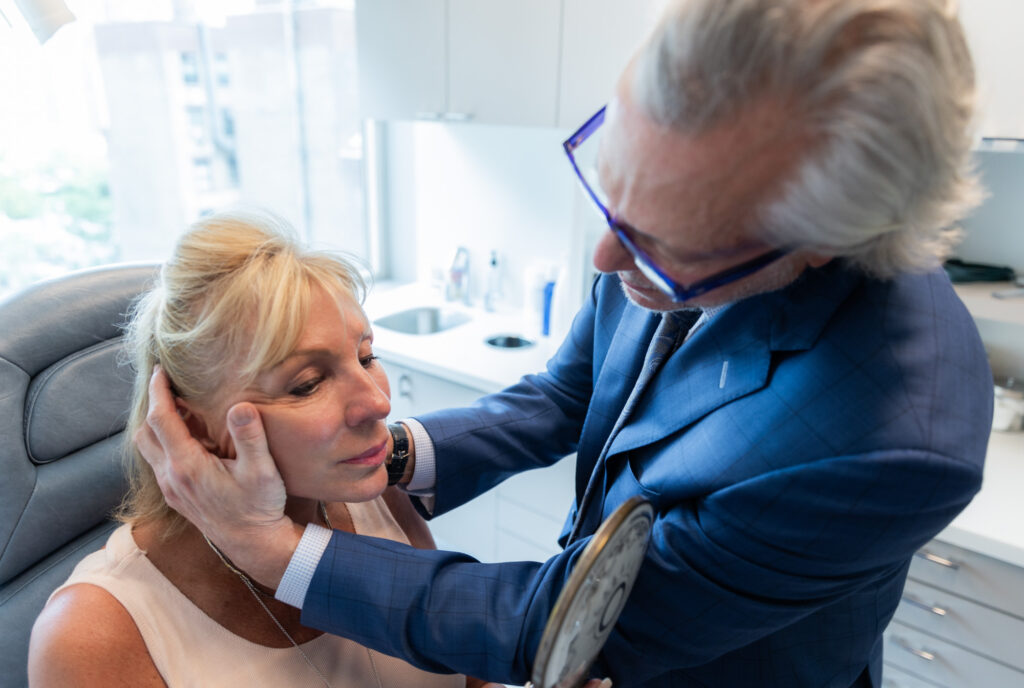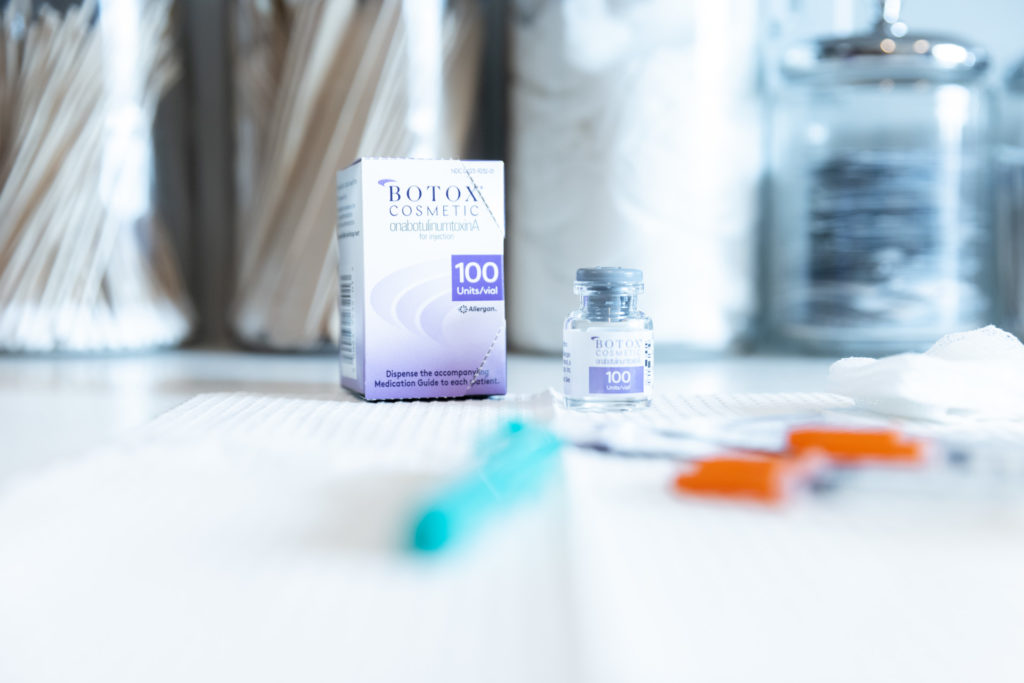
There is one thing that cannot be overlooked when you’re considering a facelift: recovery. As with any aesthetic surgery, a facelift has a recovery period that there’s no getting around but that doesn’t have to be a negative thing!
Deciding to pursue a facelift is an admirable step in making sure you’re presenting the best possible version of yourself and can help you feel more confident in your appearance. It’s an investment that you want to protect, which is why it’s important that you know what to expect about the recovery process. Healing well helps produce optimal results.
Dr. Steven Pearlman is a dual-board certified facial plastic surgeon in New York City. He and the team at Pearlman Aesthetic Surgery are committed to making sure our patients are fully educated on all aspects of their facelift procedure, and that includes preparing them for the realities of facelift recovery in New York City.
Our Top 7 Tips For Facelift Recovery
1. Plan for downtime
There’s no getting around it. You will need time to rest and recuperate after your facelift surgery. The important thing is to keep positive and plan ahead to have the support you need. Remember that your surgeon and patient care coordinator are part of your support network too!
2. Follow your aftercare instructions
After your facelift, you’ll be given thorough aftercare instructions. Following these is essential to making your facelift recovery process smooth and can help speed up your downtime too. If you have questions, you can always reach out to your surgeon’s office.
3. Don’t neglect to get your rest!
The most important thing you can do during your facelift recovery is rest while your body is healing. Getting enough sleep, avoiding strenuous activities, and just generally taking it easy allows your body to focus its energy on healing.
4. Keep your chin level or up (or elevated)
While it’s important to stay positive through your facelift recovery process, keeping your chin up has physical benefits too. Keeping your head elevated, especially in the first few days after your surgery, helps reduce swelling. Making sure your bed is set up with a wedge pillow can help you keep your head elevated while sleeping. If you are reading in bed, watching TV or looking at your cell phone, do not look down. This constricts your neck..
5. Eat well and hydrate
Your body needs food for nutrients and energy in order to heal your incisions. Keeping hydrated also helps the body move those nutrients where they’re needed.
6. Keep your incisions clean
To avoid abnormal scarring and reduce swelling, it’s important to gently cleanse your surgery site as directed. Make sure you let your doctor know if you see any signs of infection.
7. Avoid sun exposure
Staying out of the sun protects the sensitive skin around your incisions. Along with avoiding sun exposure after your facelift, you should avoid extreme temperature changes like taking showers that are too hot.
Here’s how we speed up healing time
There are a number of ways we enhance healing and help make the signs of having surgery go away faster. All patients start Arnica Montana before surgery and continue after. This is a homeopathic medication that enhances healing.
We now use something called TXA as part of our anesthetic. This has been demonstrated in the medical literature to reduce bleeding during surgery and subsequently reduce black and blue marks after. We also respect your facial tissues by handling them gently and performing meticulous closure of all layers of your face.
The timeline for facelift recovery
Every patient is going to have their own experience recovering from facelift surgery. The timeline for your recovery will be based on your body and how well you follow aftercare instructions.
This timeline is meant to be a general guideline and not a prescriptive outcome. Most patients recover in about 4 to 6 weeks, but final results will appear in about 6 months.
Days 1 to 3
The first couple of days after surgery are when you’re going to experience the most discomfort. We often use drains in the neck to remove liquid that might collect under the skin and help the incisions close properly. These are usually removed the day after surgery before you return home. Medical studies have also shown that taking Tylenol with Advil can give you equal pain relief to narcotic painkillers but without the side effects. You can make this switch one day post-op.
Day 4
You’ll start to feel better, and while you should still be prioritizing rest, you may feel comfortable moving around some. Sometime between days 4 and 6 is when patients usually can stop taking pain medication.
Day 6
This is when we remove the sutures in front of the ear where the skin is thinner. We remove these first because they will be ready sooner than the second set.
Day 8
On day 8, we remove the sutures from along the scalp where the skin is thicker.
1 Week
About a week and a half after your surgery, most of the bruising will have gone away. Up until this point, bruising can usually be covered with makeup.
2 Weeks
At a week and a half to 2 weeks, most patients can return to work if they don’t mind that there is still some swelling present. At 2 weeks most patients are presentable for social situations.
1 Month
Between 3 weeks and a month, patients can usually resume all of their normal functions. For important social events, such as the wedding of a close family member, Dr. Pearlman typically recommends allowing for at least 1 to 2 months of healing. If you are the parent of a bride, groom, Bar Mitzvah, or Confirmation we suggest three months so you look your best.
How type of facelift impacts recovery
There are different types of facelift surgeries and procedures and which one you receive will impact your expected recovery time.
Mini Facelift
A mini facelift is still a surgical procedure and will have a recovery period. However, it uses smaller incisions and affects less tissue and because of this, a mini facelift recovery has a shorter expected time frame.
This procedure is ideal for patients who are only experiencing minimal signs of aging along the jawline and upper neck. .
Learn more about a mini-facelift
Micro Facelift
A micro facelift uses facial fillers to enhance your natural contours and features. It’s what’s called a “non-surgical” facelift. Fillers don’t come with any downtime, but they also don’t produce the same results (in terms of both definition and duration) as an actual facelift.
There are also other types of aesthetic treatments we can use to achieve “micro facelift” results for younger patients or those who are uninterested in surgery such as Ulthera and FaceTite.
Learn more about a micro facelift
Deep Place Facelift
While Dr. Pearlman does perform many different facelift techniques in his NYC office, his favorite and most enduring is the deep plane facelift. The deep plane facelift produces longer-lasting results than a standard facelift, and it can also look more natural because all the tension is placed on the underlying muscle layer.
Experts consider this the most natural-looking facelift because it rejuvenates muscle laxity and tightens skin in one procedure. The best part? It doesn’t require any more downtime than a traditional facelift.
Interested in what type of facelift would be best for you? Check out our facelift candidacy quiz to learn more about the different types of facelifts.
Try Our Quiz
Frequently asked questions about facelift recovery
Am I going to have visible scarring after a facelift?
Any major surgery will result in a scar, but facelift scars are typically hidden by the hairline and the natural contours of the face and ear. Additionally, Dr. Pearlman employs a meticulous closure technique, resulting in a virtually invisible incision once it’s fully healed.
Facelift scars are generally not noticeable to the untrained eye unless someone is inspecting your face very closely and knows exactly what to look for.
When will I see results?
After a mini facelift, patients can often return to work or their normal routine in about a week and a half. This goes up to two weeks for a deep plane facelift. However, for important functions such as your daughter’s wedding, Dr. Pearlman suggests at least two to three months or more for a full recovery.
How long do results last?
A facelift is a permanent procedure, but the aging process continues. You will be able to enjoy younger skin for much longer than you would have otherwise. A highly skilled and experienced facial plastic surgeon can make all the difference.
With Pearlman Aesthetic Surgery, you can expect a beautiful and natural transformation that is long-lasting, with skin that looks many years younger until you get back to where you were when you had your facelift.
Does adding a neck lift increase my recovery time?
In general, adding another procedure will not increase your recovery time! Of course, this is dependent on your unique situation. A neck lift is part of the facelift process. For the deep plane facelift we routinely address the cheeks, jawline, and neck.
More questions about facelift recovery?
As a top NYC facelift surgeon, Dr. Steven Pearlman is known for providing facelift results that last and look entirely natural.
Dr. Pearlman is uniquely dual-board certified in both Facial Plastic and Reconstructive Surgery and in Otolaryngology-Head and Neck Surgery (ENT). He spent his entire medical residency and fellowship training in cosmetic and reconstructive surgery, specifically for the face.
Book your consultation to get started.
Not quite ready for an in-person visit? You can always explore our aesthetic offerings using our instant consultation tool available 24/7. Simply answer a few questions about your areas of concern and you’ll receive customized recommendations right to your inbox.




